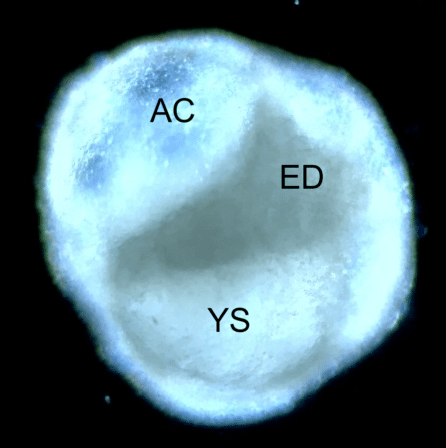New Stem Cell Model Gives Glimpse into Embryonic Life
NewsThe Context: Human embryonic development is a critical component of human life, and is a stage during which many conditions – including developmental disorders, birth defects, genetic disorders, and many neurological disorders – can begin to take form. However, very little is known about early embryo development, and it can be especially difficult to study.
The Study: Using human stem cells, scientists led by NYSCF – Robertson Stem Cell Investigator Jun Wu, PhD, of UT Southwestern Medical Center have developed an embryo model called ‘peri-gastruloids’ that can form many of the body’s cell types. The study appears in Cell.
The Importance: This model provides a rare glimpse into early embryo development and what could be going wrong in developmental disorders, pointing to new potential prevention and treatment opportunities. These models could also help to test new drugs and regenerative therapies. This study adds to the growing work about human embryo models from labs worldwide.
Gastrulation is a critical step in embryonic development in which cells begin to organize themselves into layers that will contain the basic plan for a future organism, but there are few ways to study this process in depth.
“By generating peri-gastruloids, researchers can mimic and study the complex processes that occur during gastrulation and early organ formation, which is a critical period in embryonic development,” Dr. Wu said in a press release. “This allows for a better understanding of the molecular and cellular events that shape the formation of different tissue layers.”
The Black Box of Early Human Life
How does a clump of cells turn into a human being, and what happens when this process goes awry? The answer isn’t straightforward, and is especially hard to study.
“We know a lot about animals like mice and rats. But not a lot about humans,” Dr. Wu told NPR in 2021. “It is really a black box.”
The research that can be done with human embryos is quite limited, especially given federal restrictions. Part of why NYSCF was founded was to offer scientists a private, philanthropy-driven funding source for stem cell research, which at the time could only be done using embryonic stem cells. Thanks to advances in stem cell technology since then, scientists are now able to create models of human embryos that can provide a rare insight into the earliest stages of life. In 2021, Dr. Wu’s lab published the first stem cell derived integrated human embryo model, human blastoids, which contain both embryonic and extraembryonic cells. You may have read about other studies of human embryo models in recent media coverage.
What are Peri-Gastruloids?
Scientists have already established stem cell models of gastrulation – the process of human development in which cells reorganize from a single layer to a 3D structure – but these models have lacked the diversity of cell types needed to more fully model complex development.

Dr. Wu’s peri-gastruloids contain cells found in embryos as well as those found outside embryos that help them develop.
This knowledge can be applied to improve regenerative medicine approaches, such as generating specific cell types or tissues for transplantation or repairing damaged organs,” said lead author Lizhong Liu, PhD, Assistant Instructor of Molecular Biology in the Wu lab.
These embryos are not viable, as they still lack trophoblasts (cells found in the placenta that nourish embryos), but can help provide a glimpse into critical stages of development that could not be previously studied.
The scientists can also glean insights into what might be going wrong in developmental disorders, as well as how they can intervene to prevent or treat these conditions. The models can also be used as testing material for potential new drugs and other interventions.
“Studying peri-gastruloids allows researchers to gain insights into how abnormalities or genetic mutations can impact the early stages of human development,” said Dr. Wu. “This knowledge can be used to model and understand developmental disorders or diseases that arise during early embryonic development. Additionally, peri-gastruloids can serve as a platform for testing the efficacy and safety of potential drugs or therapies targeting these conditions.”
Future Implications
While recent news reports of human embryo models sparked ethical discussions, it is important to note that this work is about understanding the process of development, not carrying it out in full. Additionally, these embryo models are not sophisticated enough to become a viable fetus – they only serve to offer a way to glean understanding of the developmental process.
“Peri-gastruloids are not viable due to the exclusion of trophoblasts that give rise to the placenta, which helps assuage the ethical concerns of this research,” said Dr. Wu. “This project followed the 2021 Guidelines for Stem Cell Research and Clinical Translation released by the International Society for Stem Cell Research (ISSCR). The duration of the culture of peri-gastruloids was carefully calibrated to the minimal necessary time period for the examination of gastrulation and the incipient stages of organogenesis in human development.”
“Overall, the study’s findings on peri-gastruloids contribute to the advancement of clinical solutions by providing a platform for regenerative medicine, disease modeling, and drug testing, which have the potential to lead to the development of new therapies, improved treatment strategies, and enhanced safety assessment methods for the benefit of patients,” said Dr. Wu.
Journal Article:
Modeling post-implantation stages of human development into early organogenesis with stem-cell-derived peri-gastruloids
Lizhong Liu, Seiya Oura, Zachary Markham, James N. Hamilton, Robin M. Skory, Leijie Li, Masahiro Sakurai, Lei Wang, Carlos A. Pinzon-Arteaga, Nicolas Plachta, Gary C. Hon, Jun Wu. Cell. 2023. DOI: https://doi.org/10.1016/j.cell.2023.07.018

